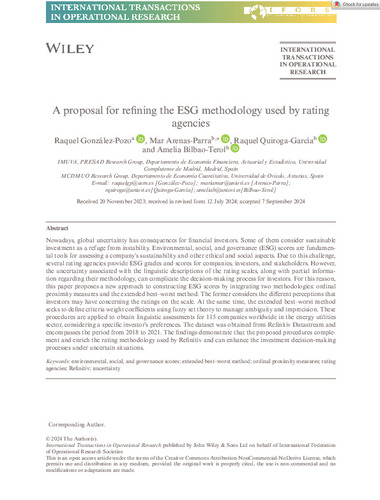A proposal for refining the ESG methodology used by rating agencies
Autor(es) y otros:
Palabra(s) clave:
Environmental, social, and governance scores
Extended best–worst method
Ordinal proximity measures
Rating agencies
Refinitiv
Uncertainty
Fecha de publicación:
Editorial:
Wiley
Citación:
Descripción física:
Resumen:
Nowadays, global uncertainty has consequences for financial investors. Some of them consider sustainableinvestment as a refuge from instability. Environmental, social, and governance (ESG) scores are fundamen-tal tools for assessing a company’s sustainability and other ethical and social aspects. Due to this challenge,several rating agencies provide ESG grades and scores for companies, investors, and stakeholders. However,the uncertainty associated with the linguistic descriptions of the rating scales, along with partial informa-tion regarding their methodology, can complicate the decision-making process for investors. For this reason,this paper proposes a new approach to constructing ESG scores by integrating two methodologies: ordinalproximity measures and the extended best–worst method. The former considers the different perceptions thatinvestors may have concerning the ratings on the scale. At the same time, the extended best–worst methodseeks to define criteria weight coefficients using fuzzy set theory to manage ambiguity and imprecision. Theseprocedures are applied to obtain linguistic assessments for 115 companies worldwide in the energy utilitiessector, considering a specific investor’s preferences. The dataset was obtained from Refinitiv Datastream andencompasses the period from 2018 to 2021. The findings demonstrate that the proposed procedures comple-ment and enrich the rating methodology used by Refinitiv and can enhance the investment decision-makingprocesses under uncertain situations.
Nowadays, global uncertainty has consequences for financial investors. Some of them consider sustainableinvestment as a refuge from instability. Environmental, social, and governance (ESG) scores are fundamen-tal tools for assessing a company’s sustainability and other ethical and social aspects. Due to this challenge,several rating agencies provide ESG grades and scores for companies, investors, and stakeholders. However,the uncertainty associated with the linguistic descriptions of the rating scales, along with partial informa-tion regarding their methodology, can complicate the decision-making process for investors. For this reason,this paper proposes a new approach to constructing ESG scores by integrating two methodologies: ordinalproximity measures and the extended best–worst method. The former considers the different perceptions thatinvestors may have concerning the ratings on the scale. At the same time, the extended best–worst methodseeks to define criteria weight coefficients using fuzzy set theory to manage ambiguity and imprecision. Theseprocedures are applied to obtain linguistic assessments for 115 companies worldwide in the energy utilitiessector, considering a specific investor’s preferences. The dataset was obtained from Refinitiv Datastream andencompasses the period from 2018 to 2021. The findings demonstrate that the proposed procedures comple-ment and enrich the rating methodology used by Refinitiv and can enhance the investment decision-makingprocesses under uncertain situations.
ISSN:
DOI:
Patrocinado por:
This work was supported by Fundación para el Fomento en Asturias de la Investigación Científica Aplicada y la Tecnología [AYUD/2021/50878]. The financial support of the research project PID2021-122506NB-I00 funded by MICIU/AEI /10.13039/501100011033 and ERDF, EU, is acknowledged.
Colecciones
- Artículos [37556]
- Economía Cuantitativa [72]
- Investigaciones y Documentos OpenAIRE [8424]
Ficheros en el ítem





